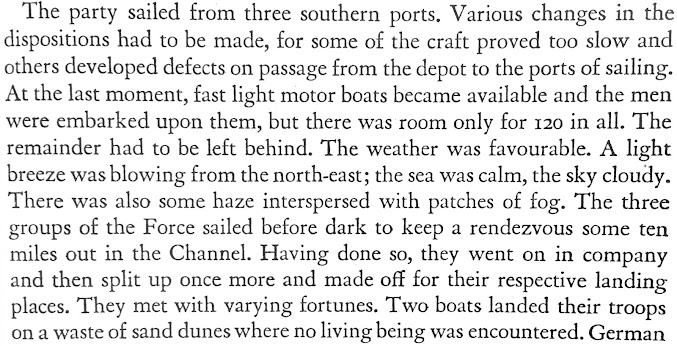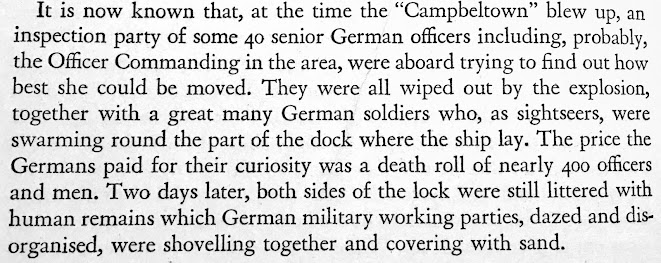Combined Operations: The Official Story of the Commandos
by Hilary St. George Saunders, Published 1943
Front and back covers - Hilary St. George Saunders also authored
The Green Beret: The Story of the Commandos 1940 - 1945
Introduction:
After reading the book I realized it is 99% identical to St. George Saunders' book under a slightly different title - Combined Operations 1940 - 1942. I do not feel like I've wasted money by buying the same book twice because I took in or understood parts more clearly second-time-'round.
Some passages meant more to me because I could see my father fully taking part in a particular exercise that was being described, now that I know more about 'where he went and when' as a member of the RCNVR and Combined Operations Command. At the same time the book is informative, entertaining and inspiring, though some will be hoping for more pages because the tale ends before the invasion of Sicily, Italy and Normandy France, 1943 - 1944. But there are many more books that will fill in details of WWII, some of which are listed under the heading (in side margin) "books re Combined Operations".
A brief review of the book is offered here - Combined Operations: The Official Story...
Below please find a few thoughtful and meaningful passages and photographs from the book at hand:
A brief review of the book is offered here - Combined Operations: The Official Story...
Below please find a few thoughtful and meaningful passages and photographs from the book at hand:
About Early Raids: June 23rd/24th, 1940
By the 15th June, 1940, a depot,
first a converted yacht but soon other quarters,
on shore had been established on the south coast of England
and the training of both Services (the Royal Navy and the Army)
in amphibious warfare began. Intense energy prevailed from the start,
and on the night of 23rd/24th June the first raid took place.
It was a reconnaissance of the French Coast between Cap d'Alprech
near Boulogne, and the Pointe du Hautbanc near Berck.
Two hundred men were to be landed in six (later changed to four) parties,
to discover the nature of the German defences, and bring back prisoners.
The landings were, if possible, to take place at
the same time in order to confuse the enemy...
over their heads but did not see them.
Another boat approached the coast near Boulogne.
When close in, the men on board her perceived that
they were in the midst of an enemy seaplane anchorage.
To land undetected was obviously impossible.
It was decided to wreck one of the seaplanes;
but, as the boat moved towards it, the aircraft selected
suddenly took off and roared over their heads,
missing them by a few feet.
The Germans on shore were now on alert, and
tommy gun when the magazine fell off with a clatter.
The Germans opened fire and then fled.
Lieutenant-Colonel Clarke was hit a glancing blow behind the ear.
This was the only casualty sustained throughout the operation and
the wound was superficial...
Their troubles did not end when they got to shore, for they were
then arrested by the Military Police who took them for deserters.
At another port, the companies of the ships in harbour
cheered the raiders as they made fast to the jetty.
Those cheers were echoed in the Press...
In fact, it was no more than a reconnaissance,
not even in force, but it achieved its purpose.
Not only had information of military value been brought back,
but men of the Royal Navy and the Army had together
carried out a combined operation against the enemy and
had laid the foundation of mutual confidence that
was to be of such vital importance later on.
Pages 18 - 20
Photos found on pages 16-17, Combined Operations: The Official Story...
Editor's opinion - Above photos are from HMS Quebec, Inveraray, Scotland
Below is another early story re Combined Operations Command, with Canadians involved. (First drafts of RCNVR members, including my father, were not in Comb. Ops training at this time. They would, however, arrive in Scotland less than one year later):
Deny the Spitzbergen Coal to Germany
An agreement was reached by Great Britain, the U.S.S.R.
and Norway in July 1941, that immediate steps should be taken
to deny the Spitzbergen coal to Germany.
It was not thought desirable to maintain
a permanent garrison in the islands.
What could be done was to to disable the mines as to ensure
that the Germans could derive no benefit from them, to destroy
any stocks of coal and evacuate the inhabitants.
Found on pages 16 - 17, Combined Operations: The Official Story...
No opposition from the enemy was encountered, however, and the
force anchored in Green Harbour in the Ice Sound of West Spitzbergen.
The inhabitants showed great friendliness, and immediate preparations
were made to evacuate them, the Soviet citizens
to the U.S.S.R., the Norwegians to England.
Once the former had been got aboard,
the demolition parties went to work.
Essential parts of the mining machinery were removed or destroyed.
A disused wireless station was blown up and were removed or destroyed.
A disused wireless station was blown up and the overhead conveyor system,
bringing the coal from one of the largest mines to the dock side, was destroyed.
450,000 tons of coal lying in ordered heaps were set on fire
together with 275,000 gallons of fuel oil, petrol and grease.
"Exploding barrels," states an eye-witness,"
were seen rising to a height of about 250 feet
and were thrown out from the pile, flaming,
to a distance of from 350 to 400 feet..."
...The final task was the destruction of the two wireless stations.
Of all the Allied raids that took place before the ill-fated Dieppe Raid in August 1942, the most significant and dashing was the raid at St. Nazaire. Entire books have been written about the raid, it was the first that involved a Canadian or two aboard landing crafts, and Combined Operations: The Official Story of the Commandos devotes 3 chapters and 30 detailed pages to the topic, i.e., it's goals, elaborate actions, its positive results. A few details are shared below:
Only Brest and Lorient can rival
the importance of St. Nazaire as a
German naval base for enemy forces
engaged in the battle of the Atlantic.
St. Nazaire contains not only every kind of facility
for the maintenance, arming, provisioning and repair of U-boats,
but also the only dry dock on the Atlantic seaboard
capable of holding the battleship "Tirpitz."
It was towards this great dry dock, called by some
the Forme Ecluse, by others the Forme Louis Joubert,
which is over 1,100 feet long, that the "Bismarck" was undoubtedly making
when she was sunk on the 27th May, 1941. If her sister ship, the "Tirpitz,"
were tp replace her in the Atlantic battle, she would, on return from her cruise,
have to make use of the Forme Ecluse, or else
find her way to the German North Sea bases
to undergo the necessary refitting.
Combined Operations: The Official Story of the Commandos, page 71
St. Nazaire - The Raiders Go In, as found on page 83
More about the results of the raid, sometimes called 'the Butcher's Bill':
Paragraph as found on page 98
On page 99 details re overall results and Allied losses are revealed:
...Having overcome (several) preliminary hazards
and retained surprise to the cannon's mouth, the principal object
was completely achieved and most of the demolitions
carried out with the utmost speed and effect.
could be made by a combined operation (emphasis mine, GH)
against an enemy base towards winning the Battle of the Atlantic.
The manner and method in which it was carried out
proved that it was possible for a comparatively small force
to attack a heavily-defended port under cover of darkness
by exploiting to the full the element of surprise.* Page 99
*Surprise was a critical element in the planning of an upcoming raid, again in France... upon the beaches of Dieppe. However, it was lost at approx. 0345 hours on August 19, four and a half months after the successes at St. Nazaire.
In a chapter about a little known raid (CH. 13. The Storming of Diego Suarez) on the island of Madagascar, a couple of informative paragraphs reveal more about the role of Commandos and the significance of Combined Operations Command and their need for "specially trained men", including Canadians who volunteered for Combined Operations in late 1941, at first only by the score:
Wanted: Amphibious Equipment and Specially Trained Men
Most of the Royal Navy landing ships and craft that were used
to transport the troops, which included No. 5 Commando, and to
put them ashore, were provided by Combined Operations Command.
These did not form the majority of the ships and troops taking part.
It is impossible, however, to tell the story of No. 5 Commando,
which was the Command's land contribution, without
giving some account of the land operations as a whole.
HMS Keren, portside of troopship w landing craft attached
Training and troopship Ettrick on Loch Fyne at Inveraray, Scotland
Combined Operations No. 1 Training Camp is 2 miles south
"RFA Ennerdale off Grenock (Scotland)". Photo - Joe Spencer, RCNVR, C. Ops
The Madagascar operation, in which the Command acted as
an assistant and not as a principal, brought out for the first time
what has now become one of its most important functions.
This is to provide amphibious equipment and specially trained men,
and to help generally in making possible the conduct of combined operations
on a scale much larger than those involved in raiding the enemy.
Another of its functions, equally important, is to arrange special training
for the troops who take part in these larger operations and to help stage
the final rehearsals which are carried out before
the forces chosen are launched upon the enemy.
Pages 102 - 103
More passages from Combined Operations: The Official Story of the Commandos to follow, focussing on the Dieppe Raid.
Please click here to read more about The Greatest Raid of All (re St. Nazaire)
Unattributed Photos GH
















%20copy%202.jpg)


No comments:
Post a Comment